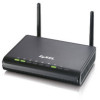ZyXEL NBG4604 User Guide - Page 160
The ACS Screen
 |
View all ZyXEL NBG4604 manuals
Add to My Manuals
Save this manual to your list of manuals |
Page 160 highlights
Chapter 16 Remote Management Table 65 Management > Remote MGMT > SNMP (continued) LABEL DESCRIPTION SNMP Settings Enable SNMP Select this to enable SNMP on this device. SNMP version Select the SNMP version that corresponds the SNMP used by the server. Read Community Enter the SNMP read community information here. Set Community Enter the SNMP get community information here. System Location Enter the SNMP system location. System Contact Enter the SNMP system contact. Trap Settings Trap Settings Select this to enable trap settings on this device. Trap Manager Type the IP address of the station to send your SNMP traps to. IP Trap Community Type the trap community, which is the password sent with each trap to the SNMP manager. The default is public and allows all requests. Apply Click Apply to save the setting to the NBG4604. Cancel Click Reset to begin configuring this screen afresh. 16.8 The ACS Screen An administrator can use an ACS to remotely set up the NBG4604, modify its settings, perform firmware upgrades, and monitor and diagnose it. In order to do so, you must enable the TR-069 feature on your NBG4604 and then configure it appropriately. (The ACS server which it will use must also be configured by its administrator.) The following terms and concepts may help as you read this part. ACS An Auto-Configuration Server (ACS) centralizes the management and configuration of a variety of networking devices such as routers, set-top boxes, Voice over IP (VoIP) gateways, and other Customer Premises Equipment (CPE). It is based on the TR-069 standard. OUI Filter An Organizationally Unique Identifier (OUI) filter blocks or forwards packets from devices with the specified OUI in the MAC address. The OUI field is the first three 160 NBG4604 User's Guide















